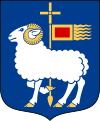
Back Gotland Afrikaans Gēatland ANG غوتلاند Arabic Islla de Gotland AST Qotland adası Azerbaijani Готланд Bashkir Готланд (востраў) Byelorussian Готлянд (востраў) BE-X-OLD Готланд Bulgarian গোতলান্দ Bengali/Bangla
 Coat of arms | |
 | |
| Geography | |
|---|---|
| Location | Baltic Sea |
| Coordinates | 57°30′N 18°30′E / 57.500°N 18.500°E |
| Archipelago | Slite archipelago |
| Total islands | 14 large + a number of smaller islands |
| Major islands | Gotland, Fårö, Gotska Sandön, Stora Karlsö, Lilla Karlsö, Furillen |
| Area | 3,183.7 km2 (1,229.2 sq mi) |
| Length | 125 km (77.7 mi) |
| Width | 52 km (32.3 mi) |
| Coastline | 800 km (500 mi) (including Fårö) |
| Highest elevation | 82 m (269 ft) |
| Highest point | Lojsta hed |
| Administration | |
| County | Gotland County |
| Municipality | Region Gotland |
| Largest settlement | Visby (pop. 23,600[1]) |
| Demographics | |
| Population | 61,001[2] (2021) |
| Pop. density | 18.4/km2 (47.7/sq mi) |
| Official name | Gotland, east coast |
| Designated | 5 December 1974 |
| Reference no. | 21[3] |
Gotland (/ˈɡɒtlənd/, Swedish: [ˈɡɔ̌tːland] ⓘ;[4] Gutland in Gutnish),[5] also historically spelled Gottland or Gothland (/ˈɡɒθlənd/),[6] is Sweden's largest island.[7][8][9][10] It is also a province/county (Swedish län), municipality, and diocese. The province includes the islands of Fårö and Gotska Sandön to the north, as well as the Karlsö Islands (Lilla and Stora) to the west. The population is 61,001,[2] of which about 23,600 live in Visby, the main town.[1] Outside Visby, there are minor settlements and a mainly rural population. The island of Gotland and the other areas of the province of Gotland make up less than one percent of Sweden's total land area. The county formed by the archipelago is the second smallest by area and is the least populated in Sweden. In spite of the small size due to its narrow width, the driving distance between the furthermost points of the populated islands is about 170 kilometres (110 mi).[11]
Gotland is a fully integrated part of Sweden with no particular autonomy, unlike several other offshore island groups in Europe. Historically there was a linguistic difference between the archipelago and the mainland with Gutnish being the native language. In recent centuries, Swedish took over almost entirely and the island is virtually monolingually Swedish in modern times. The archipelago is a very popular domestic tourist destination for mainland Swedes, with the population rising to very high numbers during summers. Among reasons include the sunny climate and the extensive shoreline on mild water. During summer Visby hosts the political event Almedalen Week followed by the Medieval Week, further boosting visitor numbers. In winter, Gotland usually remains surrounded by ice-free water and has mild weather.
Gotland has been inhabited since approximately 7200 BC.[12] The island's main sources of income are agriculture, food processing, tourism, information technology services, design, and some heavy industry such as concrete production from locally mined limestone.[13] From a military standpoint, it occupies a strategic location in the center of the Baltic Sea.
- ^ a b "Gotland i siffror, pdf". www.gotland.se. Region Gotland. pp. 65–67. Archived from the original on 10 September 2013. Retrieved 13 June 2014.
- ^ a b "Statistics Sweden (as of December 31, 2021)". Archived from the original on 15 November 2022. Retrieved 15 November 2022.
- ^ "Gotland, east coast". Ramsar Sites Information Service. Archived from the original on 28 May 2018. Retrieved 25 April 2018.
- ^ http://sok.saol.se/pages/P296_M.jpg Archived 13 January 2014 at the Wayback Machine Svenska Akademiens ordlista, 6 February 2013
- ^ "Namnet Gotland" [The name Gotland]. www.guteinfo.com. Guteinfo. Archived from the original on 5 April 2015. Retrieved 7 April 2015.
- ^ "Gotland definition and meaning | Collins English Dictionary". Archived from the original on 20 June 2012. Retrieved 11 February 2012.
- ^ Renate Platzöder; Philomène A. Verlaan (1996). The Baltic Sea: new developments in national policies and international cooperation, Volume 1. Martinus Nijhoff Publishers. ISBN 90-411-0357-0.
- ^ Sailing Directions, Baltic Sea. ProStar Publications. 1978. ISBN 978-1-57785-759-4.
- ^ Knowles, Heather (2010). Passport Series: Western Europe. Lorenz Educational Press. ISBN 978-1-4291-2255-9. Archived from the original on 2 May 2023. Retrieved 11 November 2020.
- ^ Encyclopædia Britannica. "Zealand". Britannica.com. Archived from the original on 14 October 2014. Retrieved 31 May 2014.
- ^ "Distance Hoburg, Gotlands-Kommun, SWE → 57.96006234498054,19.34967041015625". Distance.to. Archived from the original on 27 April 2021. Retrieved 27 April 2021.
- ^ Larsson, Per. "Oväntade fynd i grotta på Stora Karlsö – Stockholms universitet". www.su.se (in Swedish). Archived from the original on 28 August 2021. Retrieved 28 August 2021.
- ^ Cite error: The named reference
Faktawas invoked but never defined (see the help page).
© MMXXIII Rich X Search. We shall prevail. All rights reserved. Rich X Search